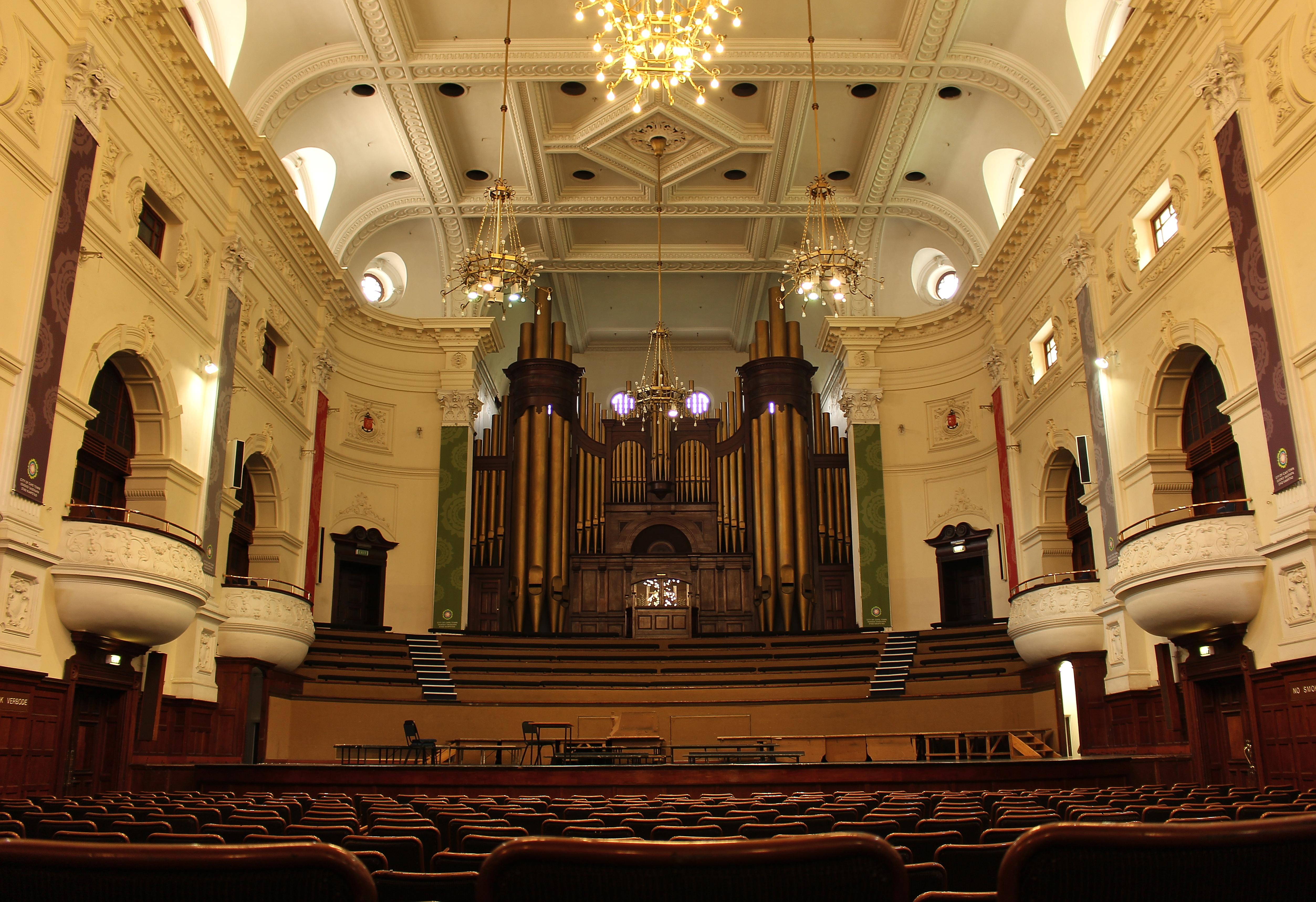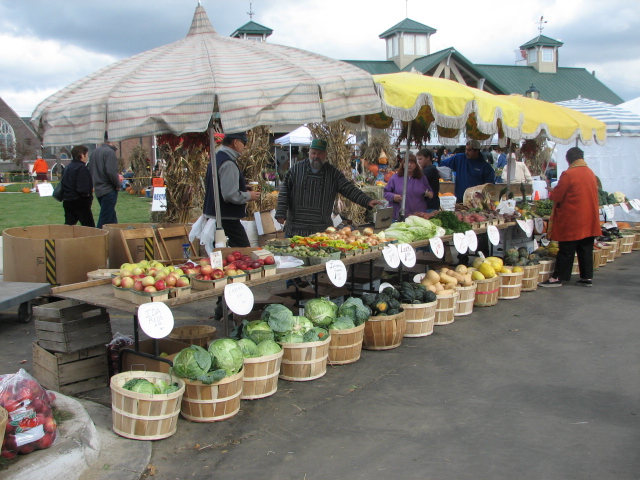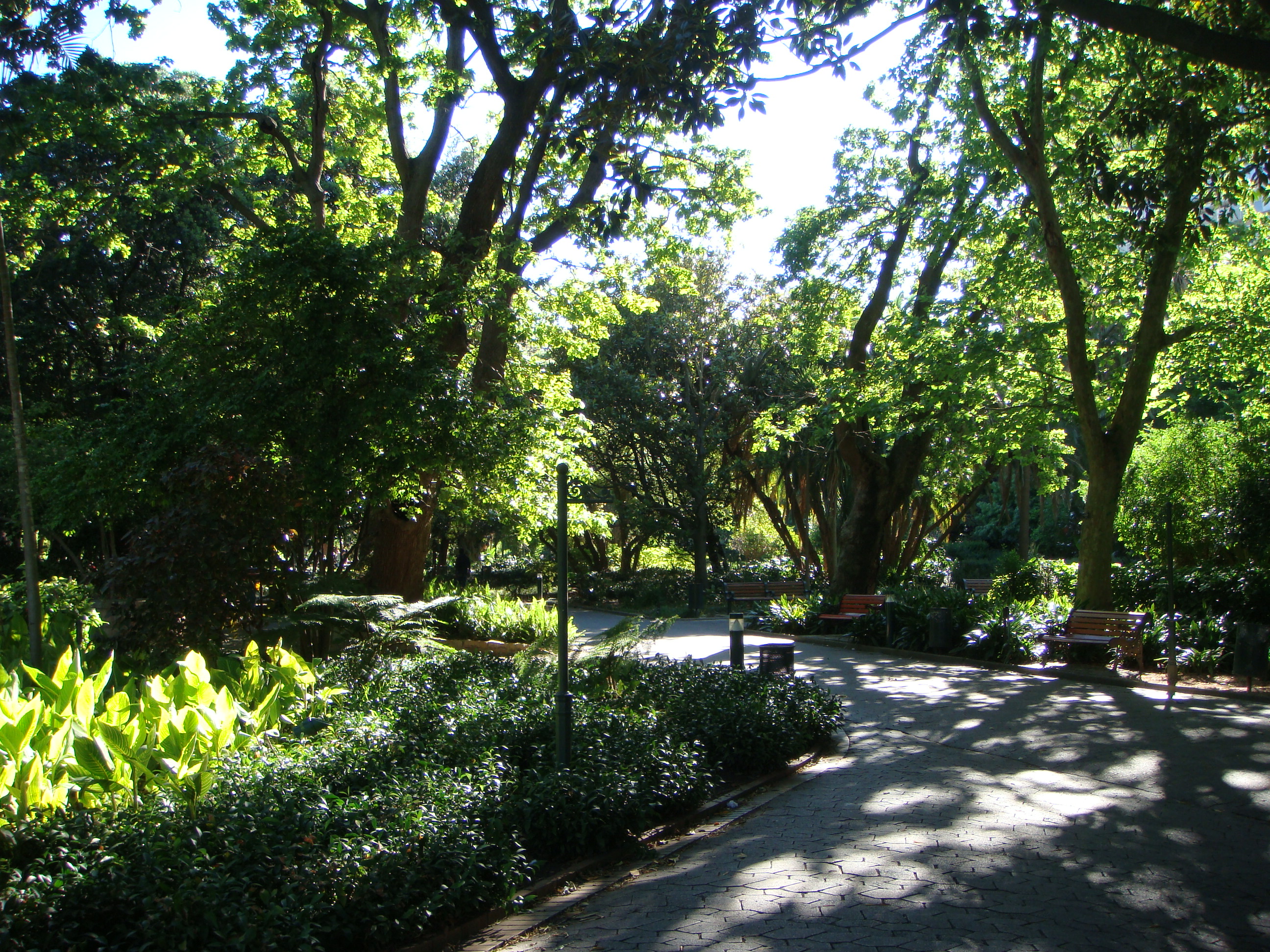|
Greenmarket Square
Greenmarket Square is a historical square in the centre of old Cape Town, South Africa. The square was built in 1696, when a burgher watch house was erected. Over the years, the square has served as a slave market, a vegetable market, a parking lot and more recently, a flea market trading mainly African souvenirs, crafts and curios. Near the centre of the square is a hand-operated pump used to bring clean water to the surface from an underground river that runs through the city. During the apartheid era, Greenmarket Square was often the focus of political protests, due in part to its proximity to parliament, as well as the ethnicity of its traders and shoppers. Location The square is located in the centre of the city bowl area of Cape Town's city centre between St George's Mall to the south east and Long Street to the square's north west. Strand Street is located to the north of the square and Wale Street to the South. The area in front of the front door of the Old Town Hous ... [...More Info...] [...Related Items...] OR: [Wikipedia] [Google] [Baidu] |
South Africa
South Africa, officially the Republic of South Africa (RSA), is the southernmost country in Africa. It is bounded to the south by of coastline that stretch along the South Atlantic and Indian Oceans; to the north by the neighbouring countries of Namibia, Botswana, and Zimbabwe; and to the east and northeast by Mozambique and Eswatini. It also completely enclaves the country Lesotho. It is the southernmost country on the mainland of the Old World, and the second-most populous country located entirely south of the equator, after Tanzania. South Africa is a biodiversity hotspot, with unique biomes, plant and animal life. With over 60 million people, the country is the world's 24th-most populous nation and covers an area of . South Africa has three capital cities, with the executive, judicial and legislative branches of government based in Pretoria, Bloemfontein, and Cape Town respectively. The largest city is Johannesburg. About 80% of the population are Black South Afri ... [...More Info...] [...Related Items...] OR: [Wikipedia] [Google] [Baidu] |
City Bowl
The City Bowl is a part of Cape Town in South Africa. It is a natural amphitheatre-shaped area bordered by Table Bay and defined by the mountains of Signal Hill, Lion's Head, Table Mountain and Devil's Peak. The area includes the central business district of Cape Town (CBD), the harbour, the Company's Garden, and the residential suburbs of De Waterkant, Devil's Peak Estate, District Six, Zonnebloem, Gardens, Higgovale, Oranjezicht, Schotsche Kloof, Tamboerskloof, University Estate, Vredehoek, Walmer Estate and Woodstock. Central Business District Cape Town CBD in the City Bowl is a major business district in Cape Town’s metropolitan area and a financial centre of the Western Cape and South Africa. The South African parliament is located in Plein Street, and is the seat of government for six months in the year. The Western Cape provincial government and City of Cape Town The City of Cape Town ( af, Stad Kaapstad; xh, IsiXeko saseKapa) is the metropolitan municipa ... [...More Info...] [...Related Items...] OR: [Wikipedia] [Google] [Baidu] |
Art Deco
Art Deco, short for the French ''Arts Décoratifs'', and sometimes just called Deco, is a style of visual arts, architecture, and product design, that first appeared in France in the 1910s (just before World War I), and flourished in the United States and Europe during the 1920s and 1930s. Through styling and design of the exterior and interior of anything from large structures to small objects, including how people look (clothing, fashion and jewelry), Art Deco has influenced bridges, buildings (from skyscrapers to cinemas), ships, ocean liners, trains, cars, trucks, buses, furniture, and everyday objects like radios and vacuum cleaners. It got its name after the 1925 Exposition internationale des arts décoratifs et industriels modernes (International Exhibition of Modern Decorative and Industrial Arts) held in Paris. Art Deco combined modern styles with fine craftsmanship and rich materials. During its heyday, it represented luxury, glamour, exuberance, and faith in socia ... [...More Info...] [...Related Items...] OR: [Wikipedia] [Google] [Baidu] |
Grand Parade (Cape Town)
The Grand Parade is the main public square in Cape Town, South Africa. The square is surrounded by the Cape Town City Hall, the Castle of Good Hope, and the Cape Town railway station. The square is generally used as a market place and parking area but has also been the venue of major political rallies. It was the first place where Nelson Mandela addressed South Africans following his release from prison in 1990 and also following his election as president on 9 May 1994. The Grand Parade underwent extensive upgrades prior to being the venue for the 2010 World Cup FIFA Fan Fest in Cape Town. Gallery File:CapeTownCityHall.jpg, Cape Town City Hall File:City Hall, Cape Town.jpg, Cape Town City Hall, with Table Mountain in the background File:Statue Edward Vll on The Parade.jpg, The Statue of Edward VII File:Volunteer War Memorial on the Parade.jpg, The Volunteer War Memorial File:Holi One We Are One Colour Festival South Africa 2013.jpg, Holi Holi (), also known as the ... [...More Info...] [...Related Items...] OR: [Wikipedia] [Google] [Baidu] |
Cape Town City Hall
Cape Town City Hall is a large Edwardian building in Cape Town city centre which was built in 1905. It is located on the Grand Parade to the west of the Castle and is built from honey-coloured oolitic limestone imported from Bath in England. History The building was designed as the result of a public competition, the winning architects being Messrs Harry Austin Reid and Frederick George Green, with the contractors being Messrs T. Howard and F. G. Scott. Much of the building material, including fixtures and fittings was imported from Europe. The Organ was built by Messrs Norman and Beard of London and Norwich, the specifications were drawn up by Sir George Martin, organist of St Paul's Cathedral in London especially for the City Hall. The workmanship and materials are of high quality, and the organ made from mahogany, teak and pine. Sir George Martin spoke of it as “a magnificent instrument in every gradation of tone, from the softest stop to the most powerful tuba being f ... [...More Info...] [...Related Items...] OR: [Wikipedia] [Google] [Baidu] |
Greenmarket Square In Cape Town 1876 - Cape Colony Archives
A farmers' market (or farmers market according to the AP stylebook, also farmer's market in the Cambridge Dictionary) is a physical retail marketplace intended to sell foods directly by farmers to consumers. Farmers' markets may be indoors or outdoors and typically consist of booths, tables or stands where farmers sell their produce, live animals and plants, and sometimes prepared foods and beverages. Farmers' markets exist in many countries worldwide and reflect the local culture and economy. The size of the market may be just a few stalls or it may be as large as several city blocks. Due to their nature, they tend to be less rigidly regulated than retail produce shops. They are distinguished from public markets, which are generally housed in permanent structures, open year-round, and offer a variety of non-farmer/non-producer vendors, packaged foods and non-food products. History The current concept of a farmers' market is similar to past concepts, but different in relation ... [...More Info...] [...Related Items...] OR: [Wikipedia] [Google] [Baidu] |
City Hall
In local government, a city hall, town hall, civic centre (in the UK or Australia), guildhall, or a municipal building (in the Philippines), is the chief administrative building of a city, town, or other municipality. It usually houses the City council, city or town council, its associated departments, and their employees. It also usually functions as the base of the mayor of a city, town, borough, county or shire, and of the executive arm of the municipality (if one exists distinctly from the council). By convention, until the middle of the 19th century, a single large open chamber (or "hall") formed an integral part of the building housing the council. The hall may be used for council meetings and other significant events. This large chamber, the "town hall" (and its later variant "city hall") has become synonymous with the whole building, and with the administrative body housed in it. The terms "council chambers", "municipal building" or variants may be used locally i ... [...More Info...] [...Related Items...] OR: [Wikipedia] [Google] [Baidu] |
Michaelis Collection
Michaelis or Michelis is a surname. Notable people and characters with the surname include: * Adolf Michaelis, German classical scholar * Anthony R. Michaelis, German science writer * Edward Michelis, German theologian * Georg Michaelis, German politician * Gustav Adolf Michaelis, German obstetrician and namesake of the rhombus of Michaelis * Hans-Thorald Michaelis, German historian * Johann David Michaelis, German biblical scholar * John H. Michaelis, American four-star general * Laura Michaelis, American linguist * Leo Michelis, Greek-Canadian economist * Leonor Michaelis, German scientist known for Michaelis–Menten kinetics * Max Michaelis, South African financier * Margaret Michaelis-Sachs, Austrian-Australian photographer * Paul Charles Michaelis, American scientist * Peter Michaelis, German botanist * Robert Michaelis (1878–1965), French-born actor and singer who settled in England * Sebastian Michaelis, the demon butler from Kuroshitsuji * Sebastien Michaelis, French ... [...More Info...] [...Related Items...] OR: [Wikipedia] [Google] [Baidu] |
Dutch East India Company
The United East India Company ( nl, Verenigde Oostindische Compagnie, the VOC) was a chartered company established on the 20th March 1602 by the States General of the Netherlands amalgamating existing companies into the first joint-stock company in the world, granting it a 21-year monopoly to carry out trade activities in Asia. Shares in the company could be bought by any resident of the United Provinces and then subsequently bought and sold in open-air secondary markets (one of which became the Amsterdam Stock Exchange). It is sometimes considered to have been the first multinational corporation. It was a powerful company, possessing quasi-governmental powers, including the ability to wage war, imprison and execute convicts, negotiate treaties, strike its own coins, and establish colonies. They are also known for their international slave trade. Statistically, the VOC eclipsed all of its rivals in the Asia trade. Between 1602 and 1796 the VOC sent almost a million Eur ... [...More Info...] [...Related Items...] OR: [Wikipedia] [Google] [Baidu] |
Market Garden
A market garden is the relatively small-scale production of fruits, vegetables and flowers as cash crops, frequently sold directly to consumer A consumer is a person or a group who intends to order, or uses purchased goods, products, or services primarily for personal, social, family, household and similar needs, who is not directly related to entrepreneurial or business activities. T ...s and restaurants. The diversity of agriculture, crops grown on a small area of Landform, land, typically from under to some hectares (a few acres), or sometimes in greenhouses, distinguishes it from other types of farming. A wikt:market garden, market garden is sometimes called a wikt:truck farm, truck farm. A market garden is a business that provides a wide range and steady supply of fresh produce through the local growing season. Unlike large, industrial farms, which practice monoculture and mechanization, many different crops and varieties are grown and more manual labour and garden ... [...More Info...] [...Related Items...] OR: [Wikipedia] [Google] [Baidu] |
Company's Garden
The Company's Garden is the oldest garden in South Africa, a park and heritage site located in central Cape Town. The garden was originally created in the 1650s by the region's first European settlers and provided fertile ground to grow fresh produce to replenish ships rounding the Cape. It is watered from the Molteno Dam, which uses water from the springs on the lower slopes of Table Mountain. History The Dutch East India Company established the garden in Cape Town for the purpose of providing fresh vegetables to the settlement as well as passing ships. Master gardener and free burgher Hendrik Boom prepared the first ground for sowing of seed on 29 April 1652. The settlers sowed different kinds of seeds and kept record thereof each day. Through trial and error they managed to compile a calendar which they used for the sowing and harvesting throughout the year. At first they grew salad herbs, peas, large beans, radish, beet, spinach, wheat, cabbage, asparagus and turnips amo ... [...More Info...] [...Related Items...] OR: [Wikipedia] [Google] [Baidu] |
1762 Rach Greenmaqrket Square
Year 176 ( CLXXVI) was a leap year starting on Sunday (link will display the full calendar) of the Julian calendar. At the time, it was known as the Year of the Consulship of Proculus and Aper (or, less frequently, year 929 ''Ab urbe condita''). The denomination 176 for this year has been used since the early medieval period, when the Anno Domini calendar era became the prevalent method in Europe for naming years. Events By place Roman Empire * November 27 – Emperor Marcus Aurelius grants his son Commodus the rank of ''Imperator'', and makes him Supreme Commander of the Roman legions. * December 23 – Marcus Aurelius and Commodus enter Rome after a campaign north of the Alps, and receive a triumph for their victories over the Germanic tribes. * The Equestrian Statue of Marcus Aurelius is made. It is now kept at Museo Capitolini in Rome (approximate date). Births * Fa Zheng, Chinese nobleman and adviser (d. 220) * Liu Bian, Chinese emperor of the Han Dynasty (d ... [...More Info...] [...Related Items...] OR: [Wikipedia] [Google] [Baidu] |

_interior.jpg)



%2C_Hoorn.jpg)
.jpg)
